Wavefront Characteristics of a Digital Holographic Optical Element
Abstract
:1. Introduction
2. Setups for Recording and Measuring the Optical Characteristics of Digital HOEs
3. Focusing and Wavefront Characteristics of Reconstructed Images from DMDs
4. Focusing and Wavefront Characteristics of a Spherical Mirror and HOEs
5. Reconstructed Wavefronts of the Test Subjects
6. Conclusions
Author Contributions
Funding
Data Availability Statement
Acknowledgments
Conflicts of Interest
References
- Collier, R.J.; Burckhardt, C.B.; Lin, L.H. Optical Holography; Student Edition; Academic Press: New York, NY, USA, 1971. [Google Scholar]
- Zebra Imaging Inc.; Klug, M.A.; Newawanger, C.; Huang, Q.; Holzbach, M. Active Digital Hologram Displays. U.S. Patent 7,227,674, 5 June 2007. [Google Scholar]
- Wakunami, K.; Oi, R.; Senoh, T.; Sasaki, H.; Ichihashi, Y.; Yamamoto, K. Wavefront printing technique with overlapping approach toward high definition holographic image reconstruction. In Three-Dimensional Imaging, Visualization, and Display 2016; SPIE: Bellingham, WA, USA, 2016; p. 9867. [Google Scholar]
- Dallas, W.J. Computer Generated Holograms. In The Computer in Optical Research, Methods and Applications; Frieden, B.R., Ed.; Topics in Applied Physics; Springer: Berlin, Germany, 1980; Volume 41. [Google Scholar]
- Slinger, C.; Cameron, C.; Stanley, M. Computer-Generated Holography as a Generic Display Technology. IEEE Computer 2005, 38, 46–53. [Google Scholar] [CrossRef]
- Komar, V.G.; Serov, O.B. Art Holography and Holographic Cinematography; Russian Edition; Iskusstvo: Moscow, Russia, 1990; pp. 132–147. [Google Scholar]
- Coomber, S.D.; Cameron, C.D.; Hughes, J.R.; Sheerin, D.T.; Slinger, C.W.; Smith, M.A.; Stanley, M. Optically addressed spatial light modulators for replaying computer-generated holograms. In Spatial Light Modulators: Technology and Applications; SPIE: Bellingham, WA, USA, 2001; Volume 4457, pp. 9–19. [Google Scholar]
- Jenkins, F.A.; White, H.E. Fundamental of Optics; Korean Student Edition; McGraw-Hill: New York, NY, USA, 1976. [Google Scholar]
- Rousset, G. Wavefront sensing. In Adaptive Optics for Astronomy; Alloin, D.M., Mariotti, J.-M., Eds.; NATO ASI Series; Kluwer Academic: Dordrecht, The Netherlands, 1994; pp. 116–137. [Google Scholar]
- Groening, S.; Sick, B.; Donner, K.; Pfund, J.; Lindlein, N.; Schwider, J. Wave-front reconstruction with a Shack-Hartmann sensor with an iterative spline fitting method. Appl. Opt. 2000, 39, 561–567. [Google Scholar] [CrossRef] [PubMed]
- Son, J.Y.; Podanchuk, D.V.; Dan’ko, V.P.; Kwak, K.D. Shack-Hartmann wave-front sensor with holographic memory. Opt. Eng. 2003, 42, 3389–3398. [Google Scholar]
- Wang, J.Y.; Silva, D. Wavefront Interpretation with Zernike Polynomials. Appl. Opt. 1980, 19, 1510–1518. [Google Scholar] [CrossRef] [PubMed]
- Lakshminarayanan, V.; Fleck, A. Tutorial Review, Zernike polynomials: A guide. J. Mod. Opt. 2011, 58, 545–561. [Google Scholar] [CrossRef]
- Webb, R. Zernike polynomial description of ophthalmic surfaces. In Ophthalmic and Visual Optics; OSA Technical Digest Series; Optica Publishing Group: Washington, DC, USA, 1992; Volume 3, pp. 38–41. [Google Scholar]
- Spitzer, C.; Ferrell, U.; Ferrell, T. (Eds.) Digital Avionics Handbook; Head-Up Displays; CRC Press: Boca Raton, FL, USA, 2001. [Google Scholar]
- Park, M.C.; Lee, B.R.; Son, J.Y.; Chernyshov, O. Properties of DMDs for Holographic Displays. J. Mod. Opt. 2015, 62, 6000–6007. [Google Scholar] [CrossRef]
- High-Resolution Technology for Liquid Crystal Microdisplays. Available online: https://www.sony-semicon.com (accessed on 15 May 2023).
- Charnes, A.; Frome, E.L.; Yu, P.L. The Equivalence of Generalized Least Squares and Maximum Likelihood Estimates in the Exponential Family. J. Am. Stat. Assoc. 1976, 71, 169–171. [Google Scholar] [CrossRef]
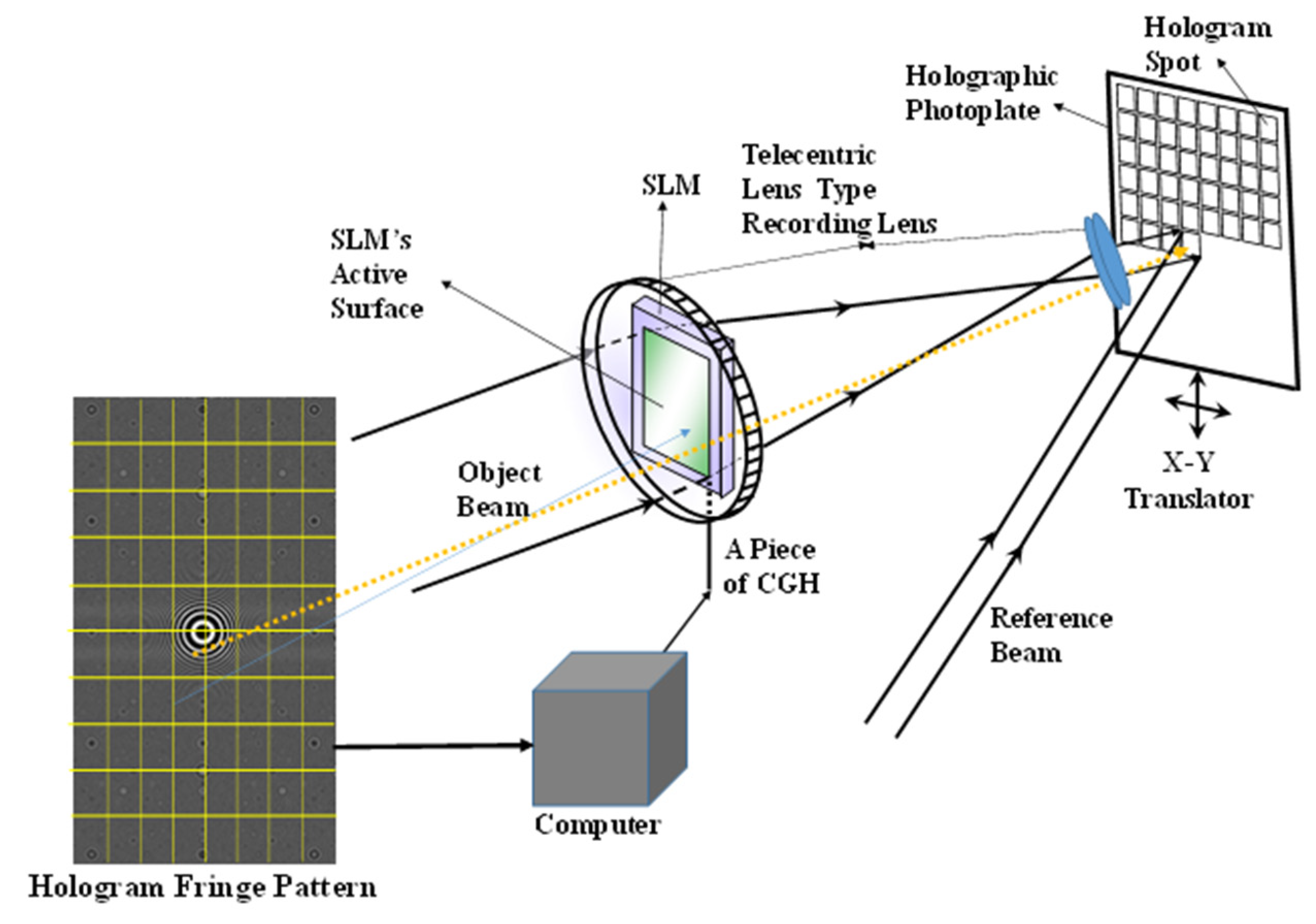

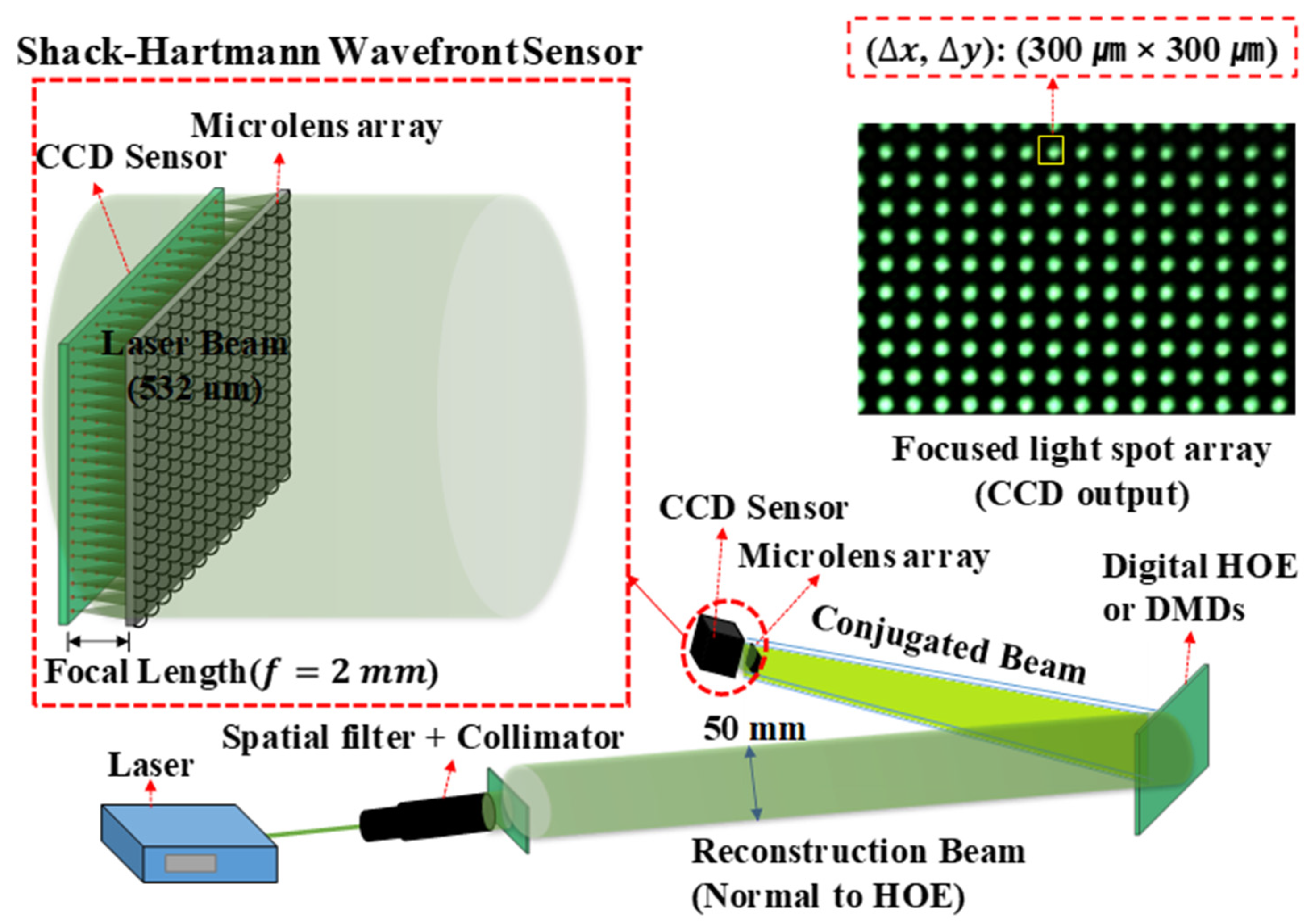
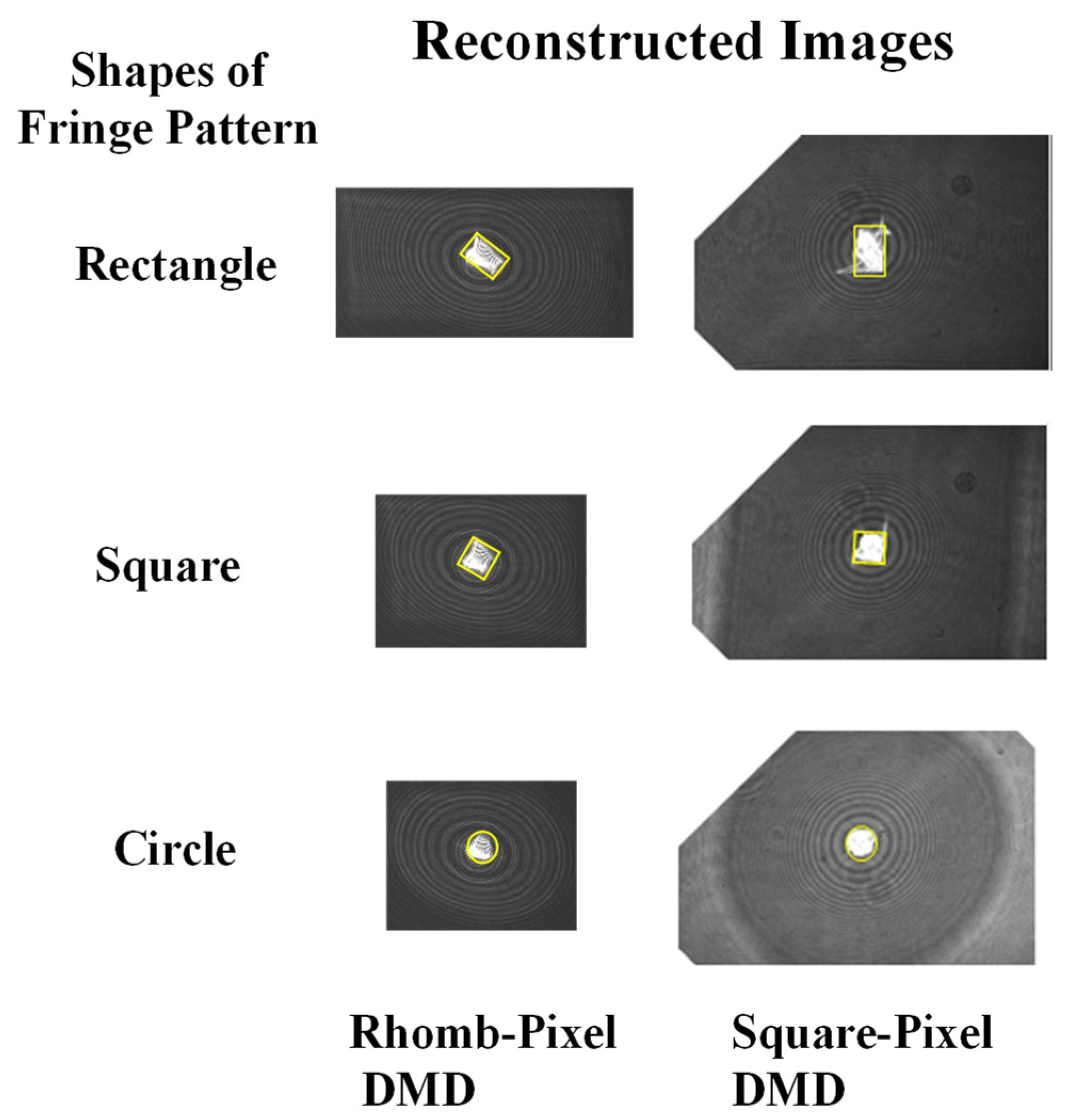
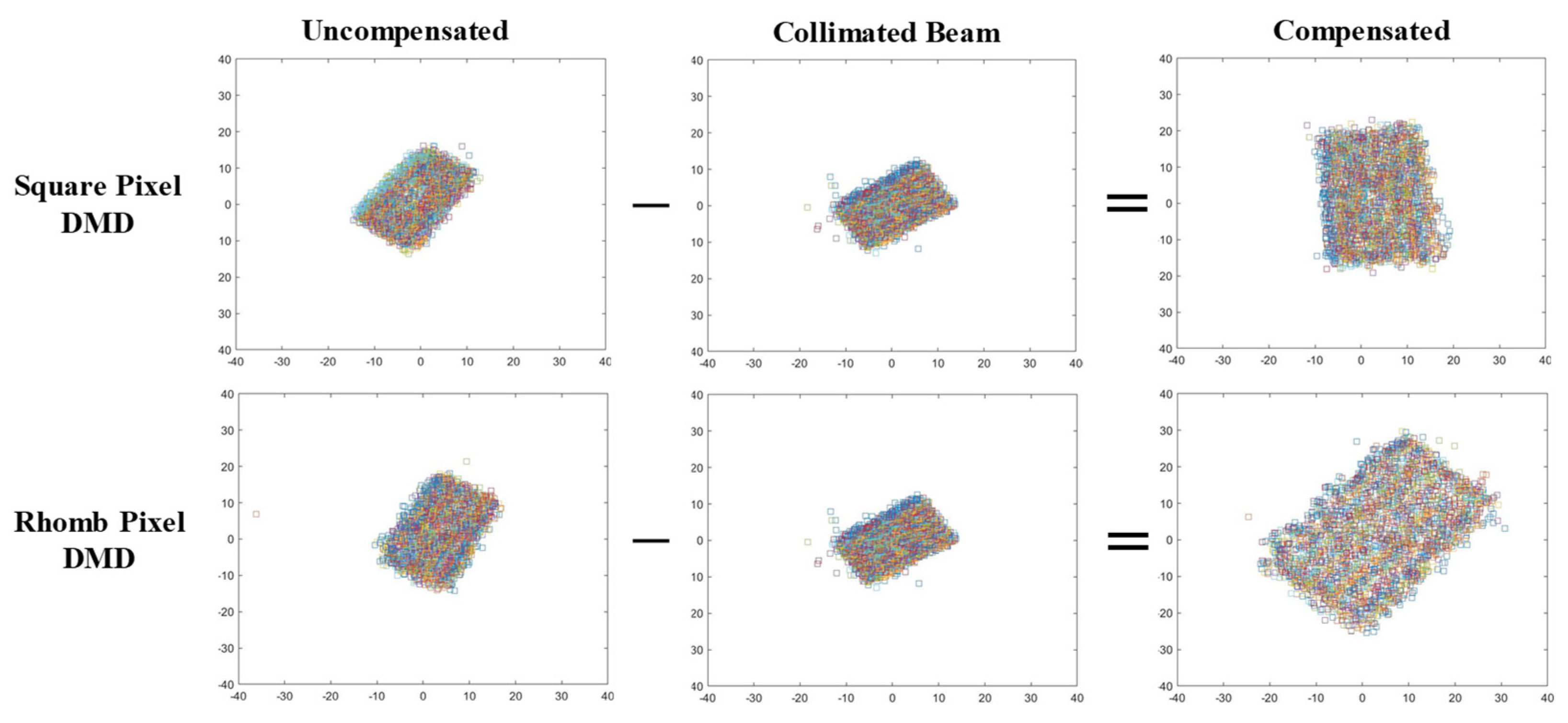
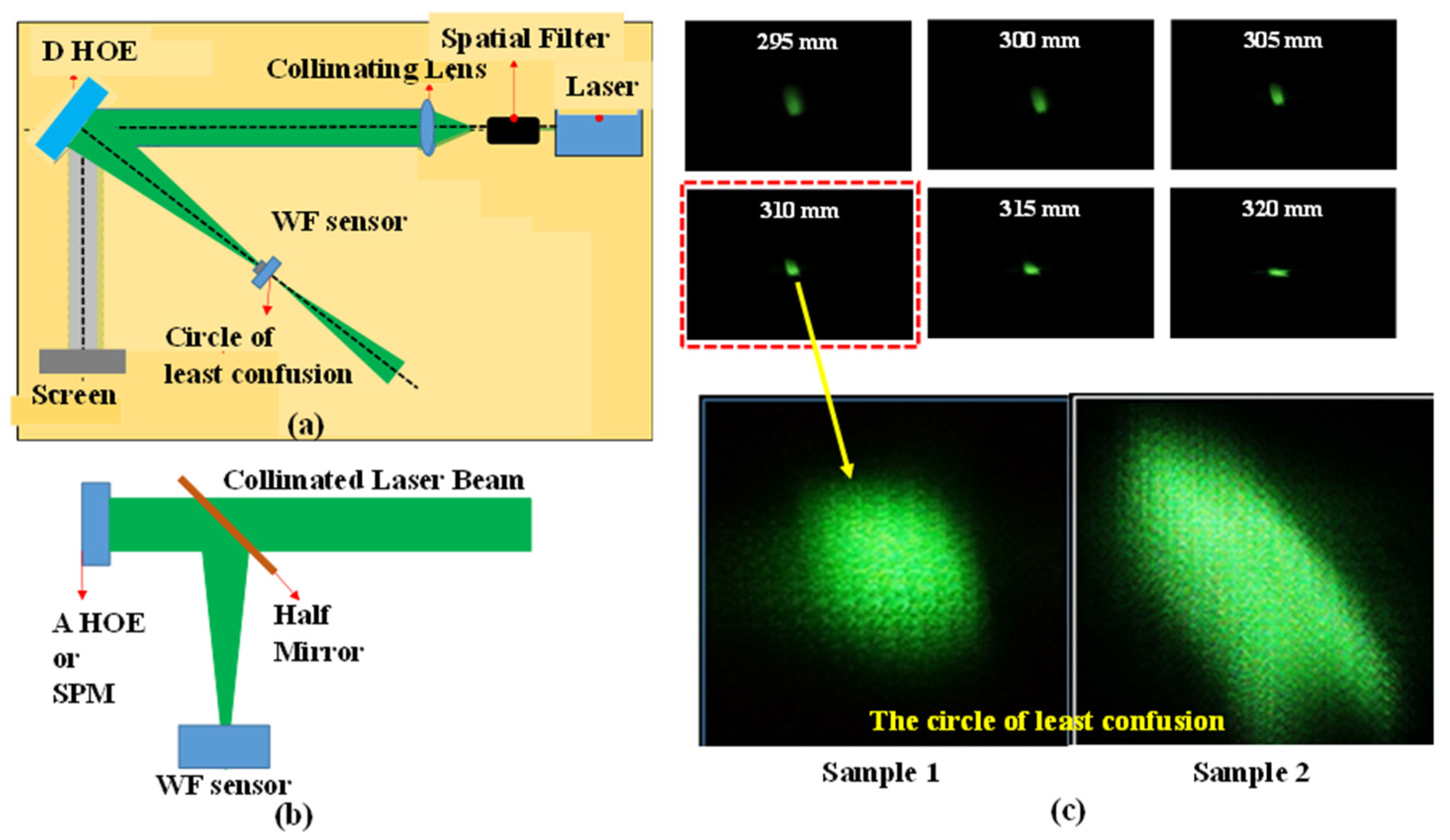
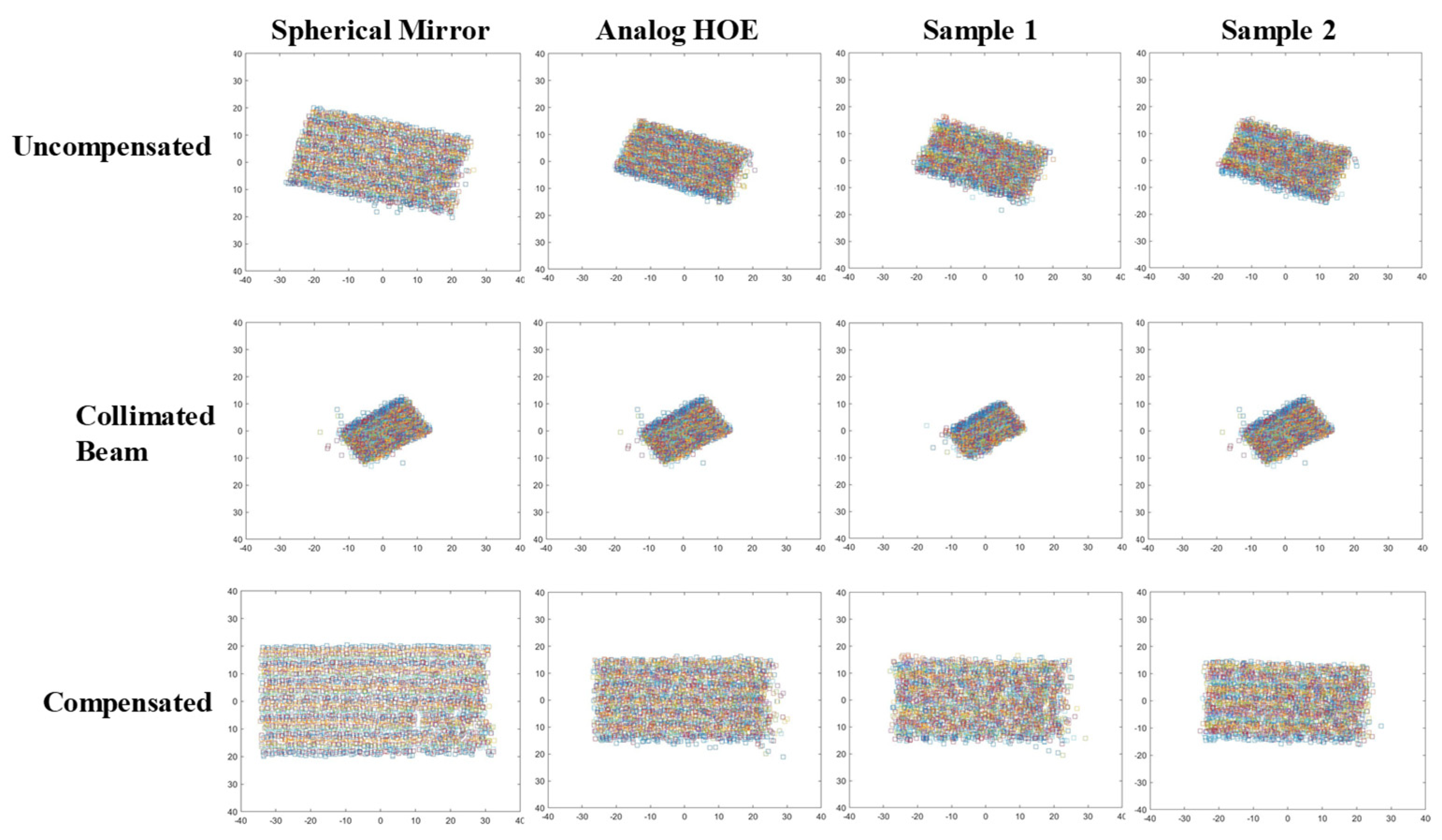

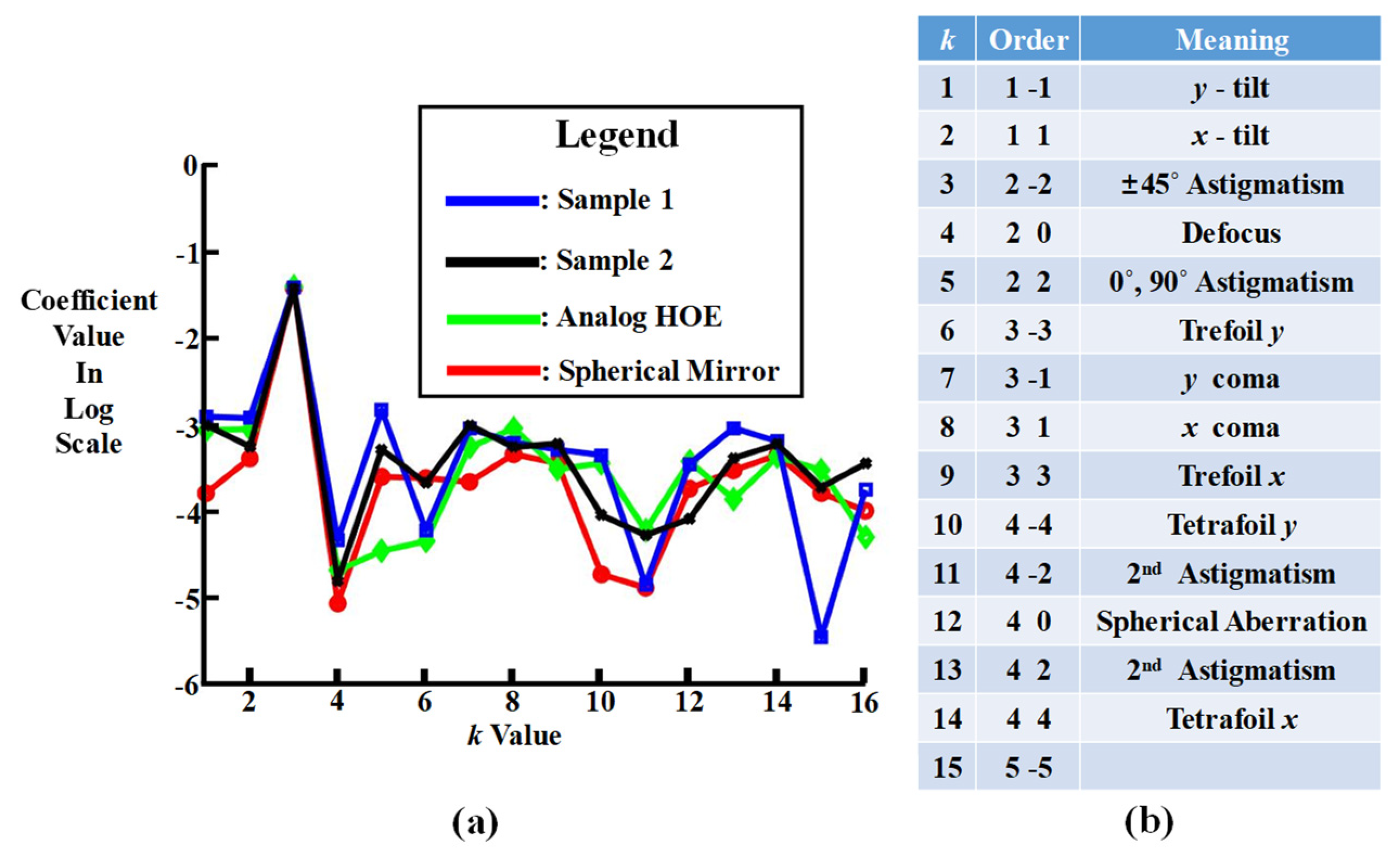

| (a) | ||
| Wavelength Differences | Deviation Angle | Pixel Numbers |
| 1𝜆 | 11.9 | |
| 16.8 | ||
| 3𝜆 | 20.5 | |
| 23.7 | ||
| 5𝜆 | 26.5 | |
| 29.1 | ||
| 7𝜆 | 31.4 | |
| 33.6 | ||
| 9𝜆 | 35.6 | |
| 37.5 | ||
| 39.4 | ||
| (b) | ||
| Pixel Numbers | Deviation Angle | |
| 2.5 | ||
| 5.0 | ||
| 7.5 | ||
| 10.0 | ||
| 12.5 | ||
| 15.0 | ||
| 17.5 | ||
| 20.0 | ||
| 22.5 | ||
| 25.0 | ||
| 27.5 | ||
| 30.0 | ||
| 32.5 | ||
| 35.0 | ||
| 37.5 | ||
| 40.0 | ||
Disclaimer/Publisher’s Note: The statements, opinions and data contained in all publications are solely those of the individual author(s) and contributor(s) and not of MDPI and/or the editor(s). MDPI and/or the editor(s) disclaim responsibility for any injury to people or property resulting from any ideas, methods, instructions or products referred to in the content. |
© 2023 by the authors. Licensee MDPI, Basel, Switzerland. This article is an open access article distributed under the terms and conditions of the Creative Commons Attribution (CC BY) license (https://creativecommons.org/licenses/by/4.0/).
Share and Cite
Lee, B.-R.; Marichal-Hernández, J.G.; Rodríguez-Ramos, J.M.; Son, W.-H.; Hong, S.; Son, J.-Y. Wavefront Characteristics of a Digital Holographic Optical Element. Micromachines 2023, 14, 1229. https://doi.org/10.3390/mi14061229
Lee B-R, Marichal-Hernández JG, Rodríguez-Ramos JM, Son W-H, Hong S, Son J-Y. Wavefront Characteristics of a Digital Holographic Optical Element. Micromachines. 2023; 14(6):1229. https://doi.org/10.3390/mi14061229
Chicago/Turabian StyleLee, Beom-Ryeol, José Gil Marichal-Hernández, José Manuel Rodríguez-Ramos, Wook-Ho Son, Sunghee Hong, and Jung-Young Son. 2023. "Wavefront Characteristics of a Digital Holographic Optical Element" Micromachines 14, no. 6: 1229. https://doi.org/10.3390/mi14061229






